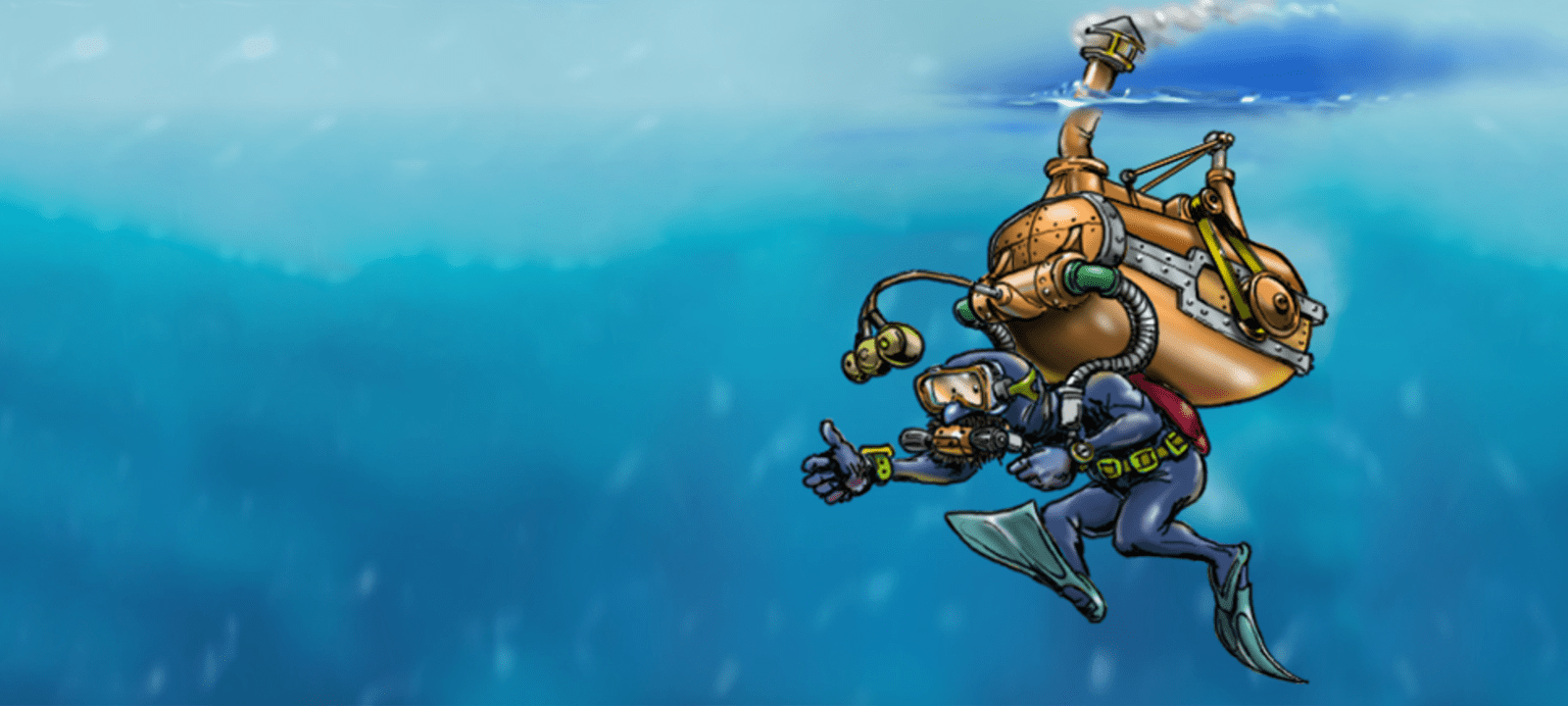
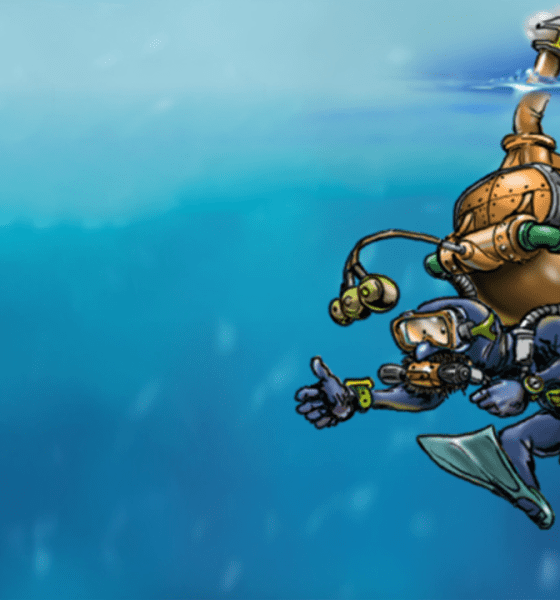
Latest Features
Peter Readey’s Incredible Steam Machine
Once dubbed the “Johnny Appleseed of Rebreathers” Peter Readey was a ubiquitous figure in the early pre-CCR days of technical diving. He would show up with a couple of his early, home-built, PRISM semi-closed rebreathers, and treat interested tekkies to try-dives in hopes they would one day order a production unit. Now for the first time, dive journalist Mark Cowan, along with Readey’s wife, Sharon Readey tell the PRISM story from inception to the development of the Hollis Prism 2.
By Mark Cowan and Sharon Readey. Header Image courtesy of Peter Readey.
See Companion Story (below): Taking PRISM To The Extreme
The weight of anxiety hung heavily from the shoulders of Peter Readey as he stood on the shore of Vivian Quarry and stared at the cold, slate blue water. On his back was his prototype semi-closed rebreather. The homemade rig was unlike anything sport divers of the day had seen before, and Pete was about to dive the unit for the first time. Only, the 33-year-old Brit wasn’t quite sure how things would go. The night before, he and his wife, Sharon, had stayed up re-sealing the seams of the homemade counterlung to make sure it didn’t flood on him.
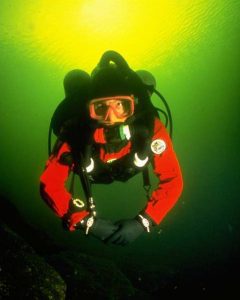
Already an experienced mixed-gas diver, Pete believed the equipment could be the future of diving. A film crew was there to capture the events for a documentary. As he stepped to the water’s edge in his grey drysuit and red hood, Pete knew that whatever happened in the next few minutes would prove his theory correct or become the biggest blooper of his diving career.
The plan on August 1, 1993, was to dive no deeper than 3 m/10 feet for a bottom time of ten minutes. Instead, sixty minutes later, after taking his rebreather to the bottom of the quarry 18m/60 feet below, Pete surfaced with a big smile and a list of problems he needed to fix.
He looked into his wife’s hopeful face. “Everything was amazing,” he told her. “I could do this all day.”
While the concept of a rebreather dates back to the 17th century, the technology didn’t find much practical application until the Second World War, when Italian and British Navy divers used basic oxygen units on sabotage missions. For almost fifty years, rebreathers were the preserve of military and scientific divers. But, by the mid-to-late eighties, things had started to change. Cave explorers like Bill Stone, Olivier Isler and Rob Palmer were using rebreathers to overcome the limitations of open circuit diving. Sport divers were witnessing the dawn of a new era; it just didn’t feel that way for many. Back then, you needed deep pockets and the right connections to get your hands on a rebreather.
If designing a rebreather for scuba enthusiasts was a feat of extraordinary ambition, it needed innovators who could combine a diver’s desire with an engineer’s mindset. Pete had come to the sport in his early thirties and quickly pushed past the standard recreational limits to find himself at the forefront of the mixed gas diving revolution in the UK.
He grew up in Sussex in southeast England, and from a young age, he wanted to be an engineer and play the guitar. So, at 18, he enlisted as a marine engineering officer cadet with Blue Star Line. After graduating, he worked on cargo ships running routes between the UK, North and South America, and Australasia. As a junior engineer, Pete’s job was to help keep things moving. If the engine or some other machinery stopped working, Pete was in his element: a broken machine was a 3D jigsaw puzzle, and he liked putting them back together.

In 1982, Blue Star hit choppy economic waters, and Pete found himself out of work. He joined his father, Colin, at the family firm restoring vintage cars and motorbikes. He met Sharon Grimsley, the younger sister of his neighbor, on a blind date. Everybody called her Shas. She shared his passion for engines. On their first date, he took her to the family workshop, and they spent the evening dismantling an engine and putting it back together again. Four years later, they were married. They had a son, Christian, in 1988.
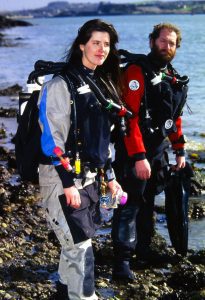
Pete fell into diving after crashing off a newly restored Bimota YB6 motorcycle during a track day. He joined North West Divers and soon found himself poking around shipwrecks. Fascinated by the history of untouched wrecks hidden on the seabed, Pete became a technical diver and soon discovered the cost of going deep. He developed an expensive ‘helium habit’ and found he was particularly susceptible to nitrogen narcosis.
Pete Readey was reading Deep Into Blue Holes by British cave explorer Rob Palmer when he found an answer to his problems. The book detailed Palmer’s quest to chart the unexplored caves of the Bahamas. During the expedition, Palmer used an electronic closed circuit rebreather made by a British inventor, Stuart Clough.
Clough’s interest in rebreathers emerged in the early 1980s while working in the petrochemical industry. He was seconded to a US company, and he trained engineers to use new CAD systems to build offshore facilities. Underwater photogrammetry and survey images were essential for ensuring the computer-assisted designs were compatible with existing structures. To get the pictures, divers needed a way to make short but deep decompression dives. Rebreathers were the answer.
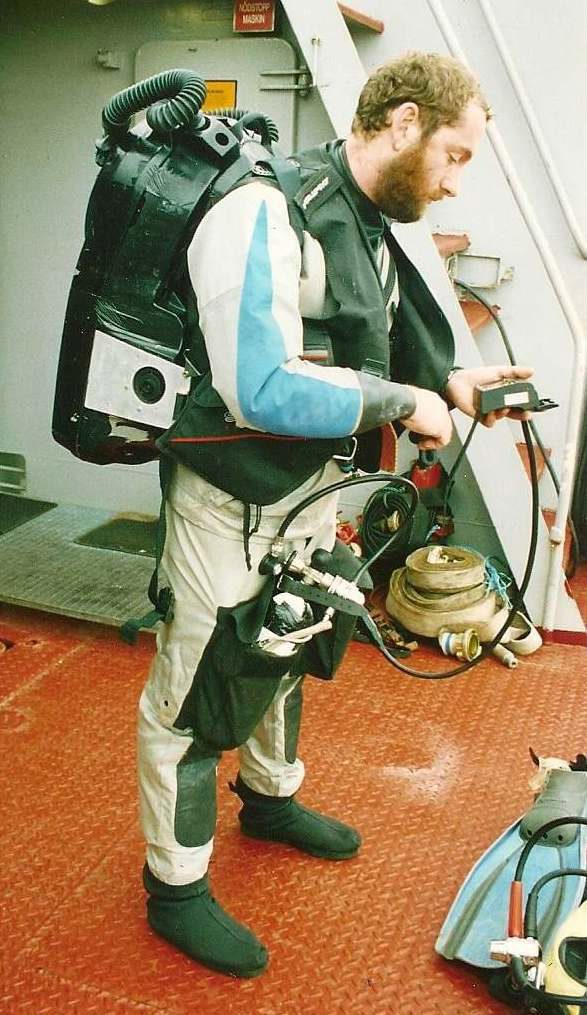
At the time, the ingredients of a rebreather were well-established. All that was missing was a control system to monitor the unit and change the breathing mix during the dive. To address that issue, Clough set up a company, called it Carmellan, and sought out experts in decompression theory and electronics. Meanwhile, he developed his computer-controlled system and rebreather decompression tables.
In Clough’s words, the first units were development platforms rather than finished products. He restricted their use to divers who understood that— divers like Palmer, as well as archaeologists and pharmaceutical companies that were looking to collect marine specimens for drug research programs.
From Clough Pete purchased a modified BioMarine-Rexnord CCR155 fitted with Carmellan’s electronic control system. Clough insisted Pete undergo psychometric testing using the unit in a hyperbaric chamber. Clough wanted to give Pete a taste of what could go wrong and see how he coped with emergencies.
The two men became friends. In Stuart Clough, Pete found someone working at the cutting edge of diving technology with leading experts in the industry. In Pete, Stuart saw a man with a real zeal for rebreathers, plenty of questions, and a willingness to jump at any opportunity to dive. Pete worked with Carmellan on deepwater operations, escorting scientists from Smith Kline to Jamaica and the South Pacific for bio-sample collections, and investigating shipwrecks for insurance companies. When Clough started developing production opportunities with big names in the diving business, Pete was there to lend the projects his engineering knowledge. He worked with Draeger on developing the SMS2000 on behalf of Carmellan, and he helped Clough conduct test dives on the prototype Phibian rebreather for Bob Hollis.
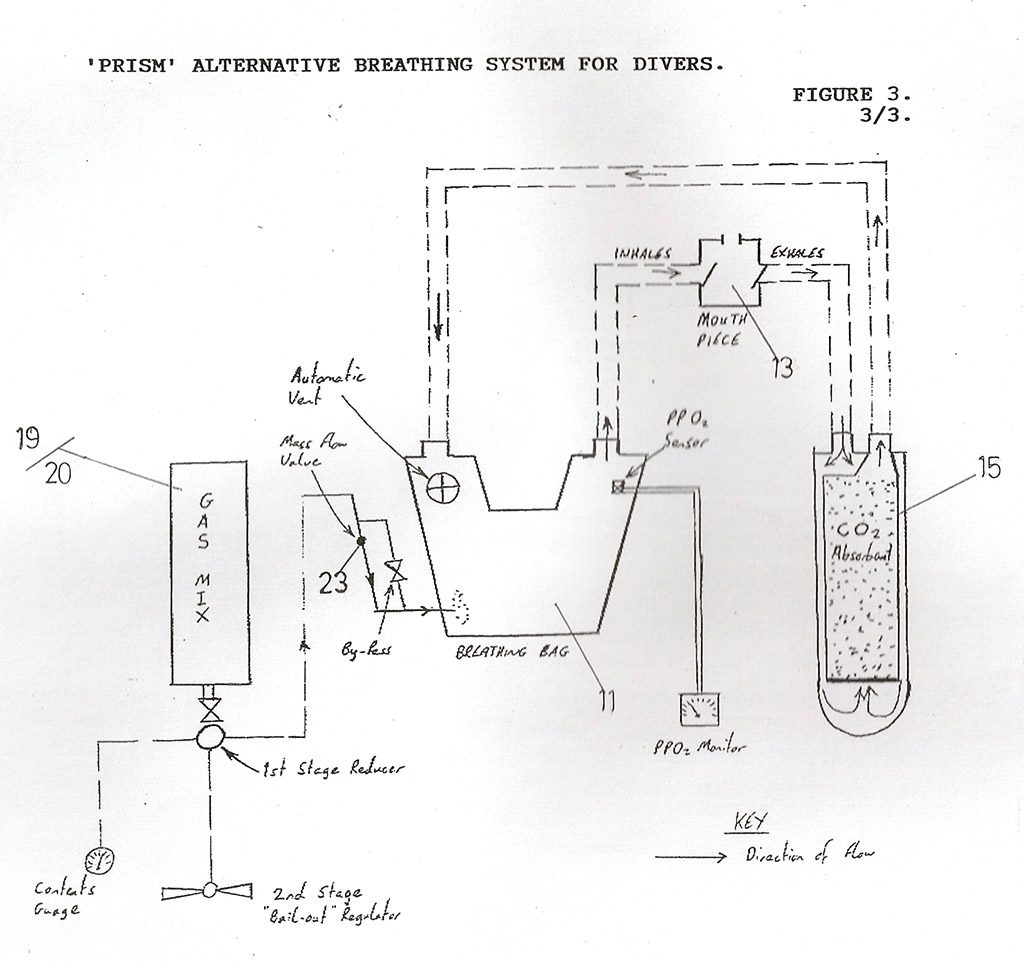
In April 1993, Pete took his diving experience, engineering expertise, and everything he had learned working with Clough, Draeger, and Oceanic and put it into his design for a semi-closed rebreather. The unit had a single, chest-mounted counterlung made from blue tarpaulin. Riveted inside was an automatic hydrostatic diluent gas addition valve. Made from two circular plastic plates – one on the front of the lung, one on the rear – the valve would allow gas into the lung when the two plates came into contact.
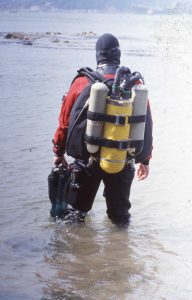
Gas flowed around the loop in the opposite direction to the rebreathers of today. The inhalation hose was routed over the diver’s right shoulder and into the counterlung on their right chest. The exhalation hose came from the counterlung on the diver’s left chest and back over the right shoulder. The mouthpiece came from a Draeger unit. There was no exhaust valve on the counterlung—that would come later—so Pete exhaled through his nose to vent expanding gas on the ascent.
A mass flow valve and a manual bypass valve were on the diver’s right side, allowing them to alter the flow of gas to match their work rate underwater.
The co-axial scrubber consisted of an outer polyethylene canister and an inner canister of stainless steel, separated by an air gap, with a curved bowl base to act as a water trap and aid gas flow. A transparent acrylic lid allowed easy visual inspection in the event of flooding. Spacers, made of a perforated membrane, stainless-steel mesh, and a dust pad, allowed gas to pass through the scrubber material, which was held in place with spring-loaded feet. Two six-liter gas cylinders were banded on either side of the canister with webbing. A Zeagle wing provided buoyancy. A single analog gauge, clipped to the diver’s left, indicated the oxygen partial pressure inside the lung. An open circuit regulator hung at the right hip as a bail-out.
Visitors who entered Pete’s workshop would stare at the contraption’s bags, pipes and hoses and jokingly refer to it as Peter Readey’s incredible steam machine. The PRISM ‘Alternative Breathing System for Divers’ was born.
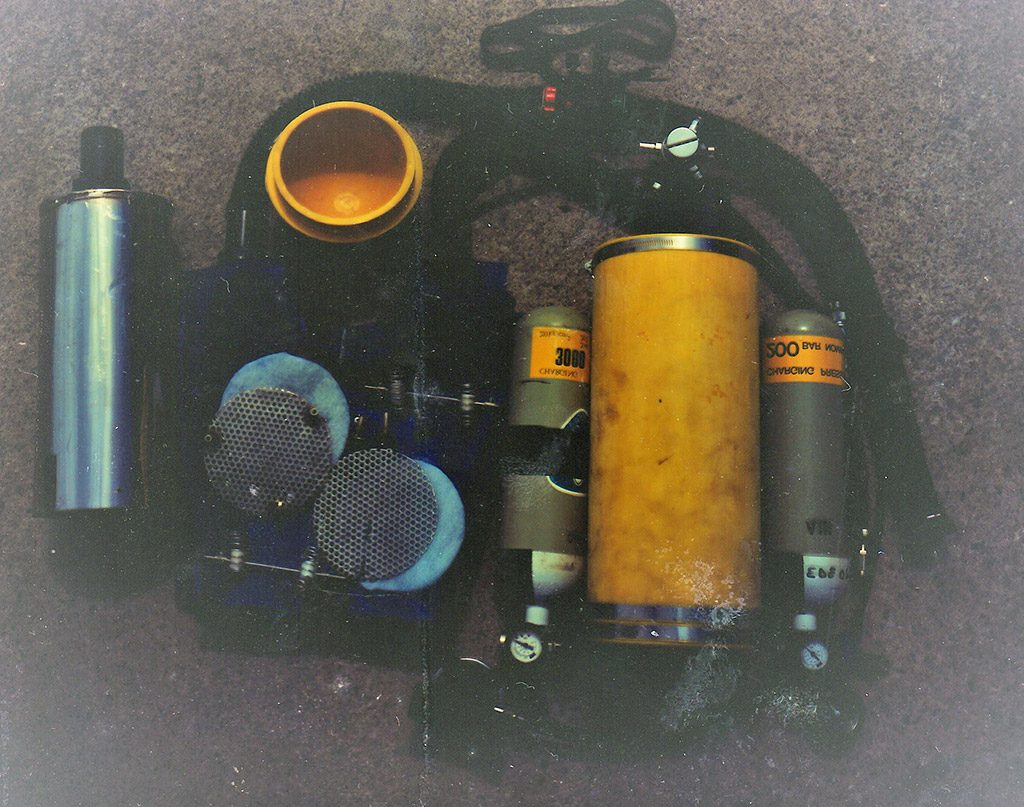
In November 1993, three months after the maiden dive, Pete took the PRISM into the hyperbaric chamber at the Diving Diseases Research Centre (DDRC), in Plymouth, on the south coast of England. Over three days, he carried out tests to assess the unit’s work of breathing, identify opportunities for improvement, and highlight potential failure points. Finally, on November 14, Pete dived the unit to a depth of 122 meters (400 feet) for 24 minutes. Stuart Clough was alongside him, testing a prototype for the Oceanic Phibian.
“There is little doubt that the rebreather is coming to the sport diving world,” wrote hyperbaric technician Dave Crockford in the May 1994 issue of Diver magazine.
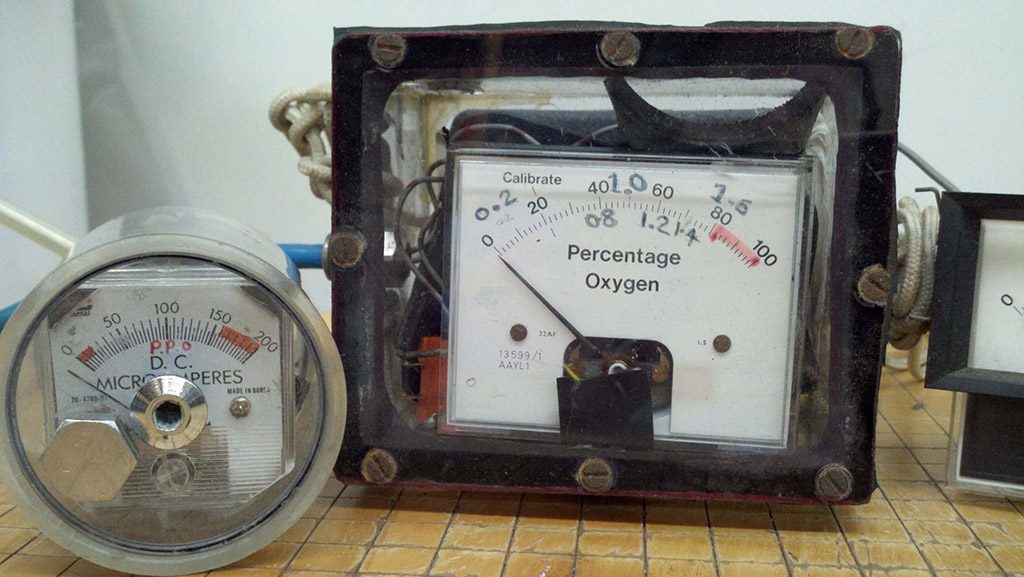
Pete wasn’t sure the dive industry felt the same way. His prototype received a lukewarm reception from investors and little interest from some of the industry’s big players; their consensus seemed to be that rebreathers were too technical, too complicated, and too dangerous for sport divers.
That irked Pete, so he set out to not only prove them wrong but to plant the idea of rebreathers in the minds of divers. At the beginning of 1994, he and Shas hit the road with his prototype rebreather and a simple plan: let’s visit dive centers and give people an underwater experience unlike anything they’d ever had.
The Johnny Appleseed of Rebreathers
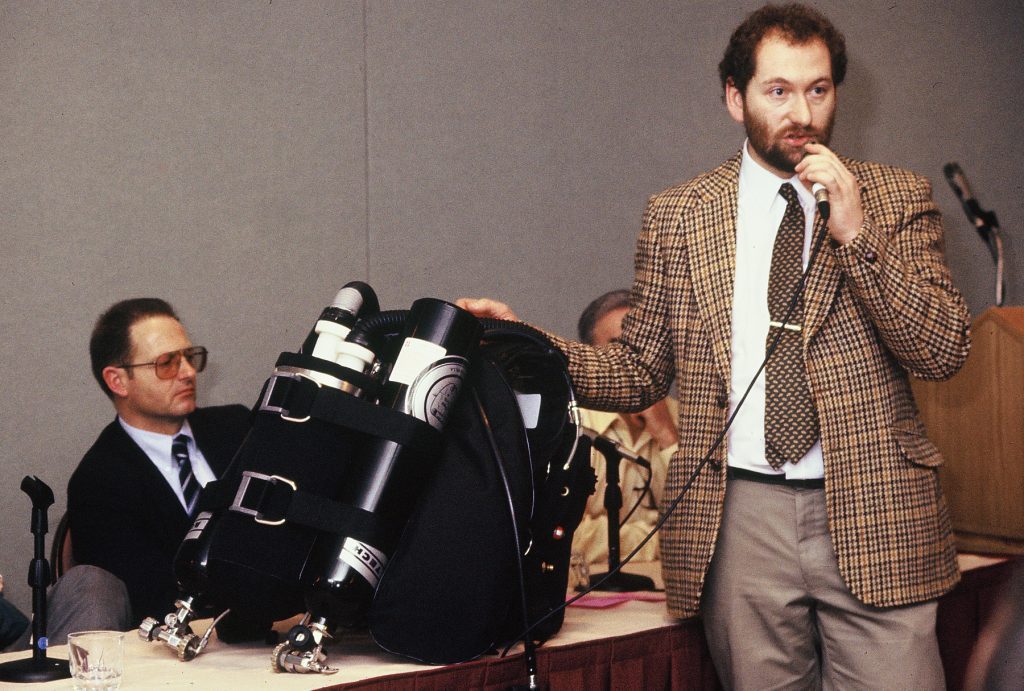
“PRISM are pleased to offer an introduction to the emerging recreational world of REBREATHERS,” stated the handout advertising Pete Readey’s first Introductory Acquaintance Day. “The aim of this day is to give you an educated opinion on alternate breathing systems.” The Introductory Acquaintance Days started the same way as most diver training courses, with hellos and waivers. Then, Pete gave a presentation outlining the different types of rebreathers and explained how the machines worked underwater. In the background, Shas prepped the PRISM for diving. After lunch, divers saw what they had paid $99 for. Then, they donned their wetsuits and, one by one, slipped into the water. They were strapped into a PRISM, and Pete showed them how to work the unit. Then, he took them on a 20-minute excursion.
No rebreather manufacturer had done anything like it before, and the interest was enormous. The couple took the Acquaintance Days across the UK. They hosted events in Ireland, Sweden, and Egypt. In April 1994, they spent two weeks in Ocala, Florida, running events at Forty Fathom Grotto, home of diving pioneer Hal Watts. Among those in attendance who were destined to glimpse the future, was journalist Lance Peterson. “The dive was brief,” he wrote in Florida Scuba News, “but the memory of the event lingers. Floating neutrally at 12m/40 feet, looking up at the mirror-like surface, unbroken by bubbles, makes more of an impression than one might think.”
The try dives proved good for business, and every spare dollar Pete and Shas earned, they invested in further testing. In June 1994, Pete was back at DDRC with six volunteers. Exercise equipment was installed inside the chamber. To test the ability of the scrubber to remove CO2, divers donned the unit and pounded a treadmill at 85 percent of their maximum heart rate. To measure the unit’s work of breathing and gas control fufunctions, divers pedaled an exercise bike.
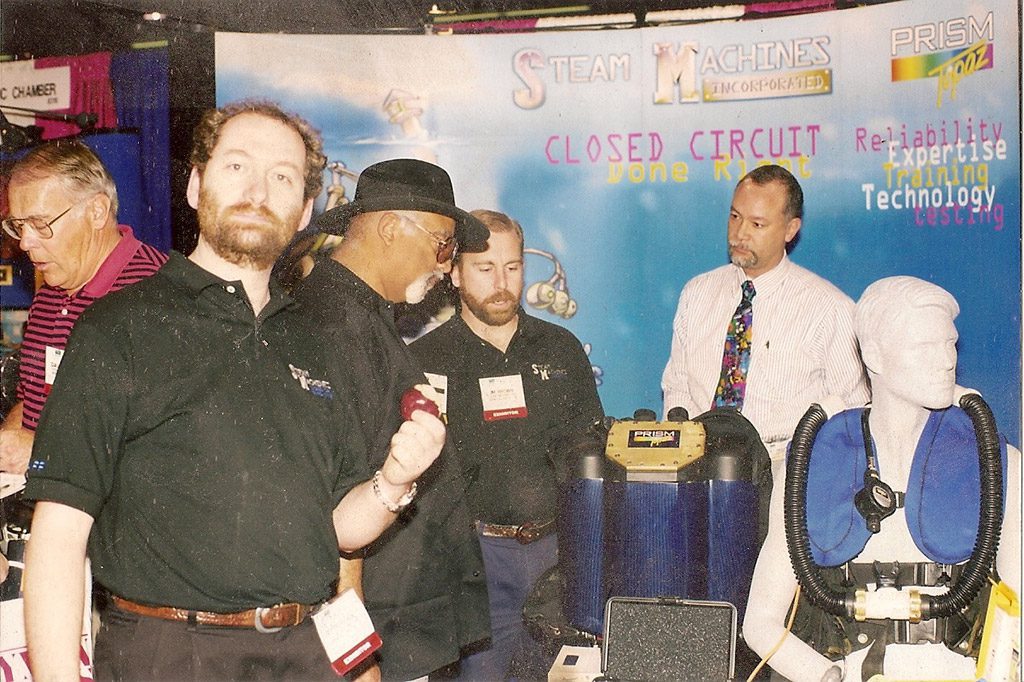
Pete and Shas were back in Ocala a month later. Then, in October, they hosted an event at the Bainbridge Sportsmen’s Club, Pennsylvania, at the invitation of future Women’s Hall of Fame diver Barb Lander. The following March, they took their Man and Machine Tour to Australia. In Perth, they put 45 divers through the experience in three days. Then they packed up, moved to Adelaide and did the same thing again. Then again in Melbourne. Then Sydney. Then Townsville and Brisbane, and then New Zealand, where they hosted events in Wellington and Auckland.
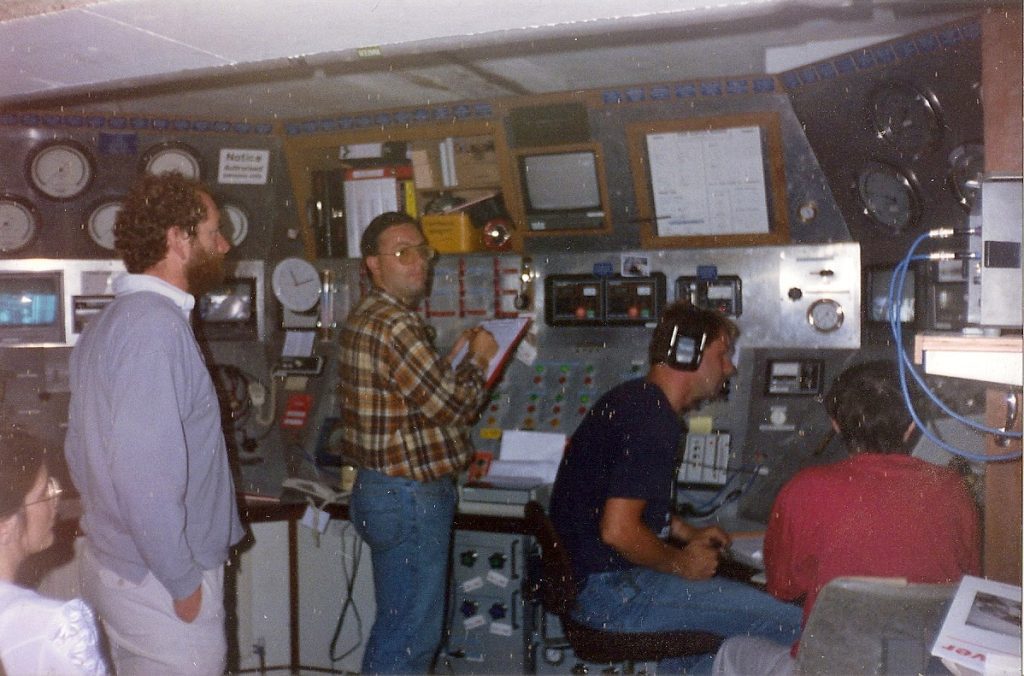
In little over 18 months, Pete had put about 1,500 divers through his rebreather experience, and people in the industry were finally beginning to take notice. Michael Menduno called him the Johnny Appleseed of Rebreathers, a reference to missionary John Chapman who traveled the US planting apple trees in the late 18th and early 19th centuries. Then, in the summer of 1995, Pete met Michael Cochran at a trade show.
Cochran was a pioneer in the field of micro processing. While working for Texas Instruments in the seventies, he co-invented the microcomputer chip. In 1993, Cochran launched the Nemesis wrist computer and single-handedly revolutionized the design of dive instrumentation.
Cochran pitched Pete a simple idea: Let’s make a rebreather together.
The marriage between the pair appeared perfect. Pete knew the mechanics of a rebreather and had a working unit; Cochran had the expertise in computing and electronics and had the manufacturing capability.
Shas was home in Cornwall, in the southwest of the UK, when Pete called and asked: Do you fancy moving to Texas?
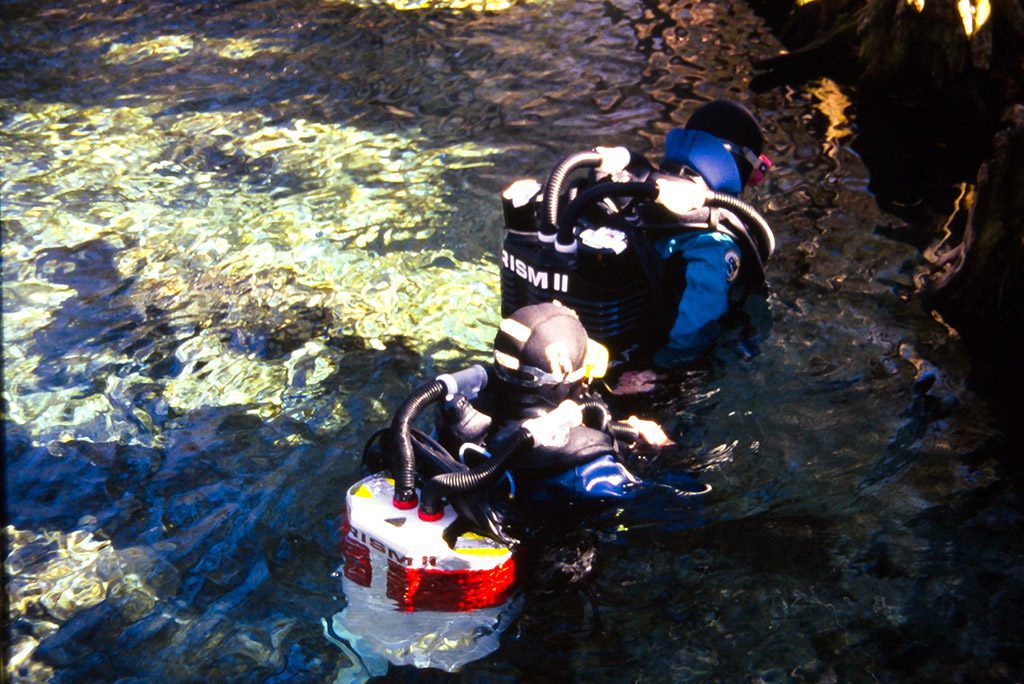
She packed their prototype PRISMS into four suitcases, threw some clothes into a cabin bag, scooped up her son, Chris, his favorite soft toy, and headed straight for the airport. It felt great to be swept up in the excitement, to be caught up in the whirlwind and go-all-in on the dream, because if she wasn’t, she might have been unnerved: unnerved that she was leaving behind her home and everything she knew, that she would be starting from scratch in a new country with no family for support, that she might have considered the whole thing foolish if she were a few years older.
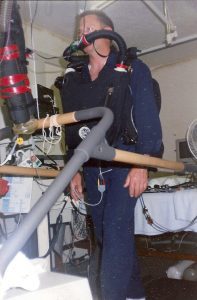
In Dallas, the race was on to get a working prototype ready for the DEMA trade show in January 1996. Fitted with an electronic control system, the unit became a fully closed circuit rebreather named Cochran PRISM II. Pete placed the electronics in a compartment beneath the scrubber, between the inner and outer canisters. The decision allowed him to keep the curved base of the inner canister. Next, he swapped the chest-mounted counterlung for twin, over-the-shoulder bags which lowered the work of breathing. He installed oxygen sensors in the inhalation lung. These sent data back to the main CPU, which controlled the operation of the oxygen gas flow valve. For that, Pete opted for a mass flow controller. The addition of electronics increased the weight of the unit. Pete incorporated the four-hour co-axial PRISM SCR scrubber canister design into the new unit to keep the weight down. Finally, the whole thing was wrapped in a case branded Cochran PRISM II.
The unit debuted at the DEMA show in New Orleans. “The PRISM II totally redefines advanced diving systems,” said the promotional material. The price, divers were told, would be between $5,000 and $7,000, depending on optional extras. One of those extras was a CO2 breakthrough detector. Pete had been experimenting with a colorimetric bio-chemical sensor with a reversible bi-color changing indicator that triggered an alarm if higher than normal levels of CO2 were detected. However, the detector still needed more work; testing indicated it could fail (safe) in some instances, particularly if the diver smoked.
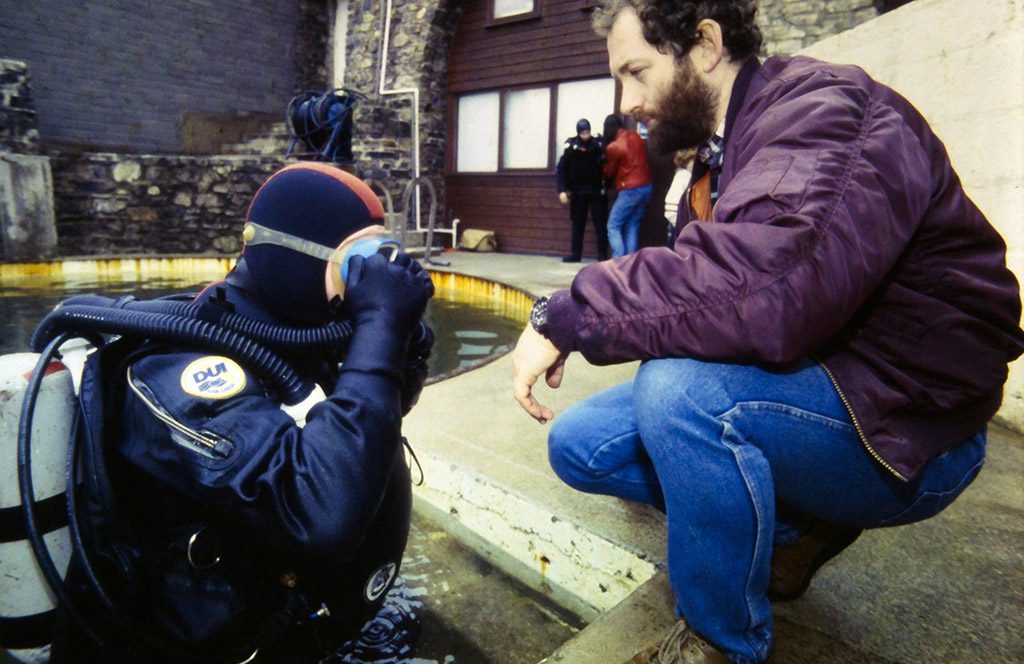
Everything was on track to have the unit on sale in December 1996. Then, Cochran’s company became embroiled in an unrelated patent infringement lawsuit. Legal bills mounted, and the PRISM II was shelved. Cochran wanted Pete to stay in Texas and offered him a job. However, there was a problem; Cochran couldn’t say when the rebreather project might resume, and Pete couldn’t turn his back on the PRISM.
So, in November 1996, he and Shas packed everything they owned into a Ryder truck. They bundled Chris in the back seat between the prototype PRISMs and a few modified Mk15.5 units the couple owned. They had no real capital to fund their next move, but they weren’t prepared to let their dream die in Dallas. Leaving the state, Pete pointed the truck towards the sun, and they headed west.
Further Product Development
The hype surrounding rebreathers reached a fever pitch in the mid-nineties. Technical divers were desperate to get their hands on a unit. At conferences, divers waved checkbooks in the air. They challenged manufacturers to sell them a working rebreather, but no one seemed ready to take their money.
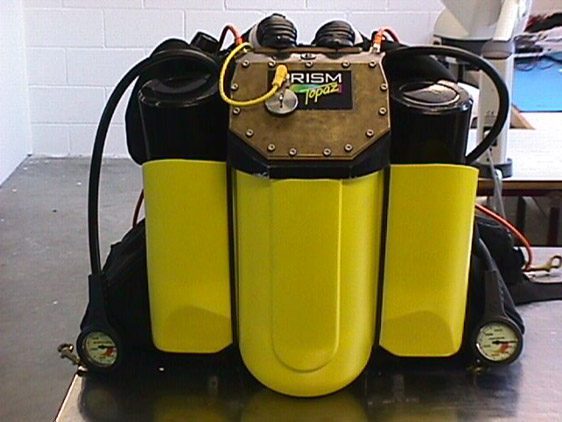
Still, plenty of designers turned up to DEMA in 1997, pushing prototypes and promises. Only two companies had units for sale, and they were both semi-closed. One was Draeger. The other was a Japanese company, Grand Bleu, with the Fieno, and no one could miss the ‘Fieno Girls’, dressed in white blouses, matching pumps, cheerleader shirts, and a Fieno rebreather, scouting the showroom floor for buyers with $2,800 to spare. The rest were telling divers that their rebreathers would be ready for production … soon.
The biggest issue seemed to be that most developers had not quite anticipated how difficult it would be to produce a reliable rebreather. Difficult–and expensive. Pete Readey knew how hard it was to make a reliable rebreather and how easy it was to build one badly. He’d spent years testing and fine-tuning the PRISM. His round-the-world try-dive series had put thousands of logged dives into the books, he’d watched divers use his machine, and he’d worked out the bugs of his design, and he was still nowhere near production.
After leaving Dallas, he and Shas settled in Hermosa Beach, southwest of Los Angeles, California. They moved into a small rental unit five blocks from the beach and launched Steam Machines. They offered training on rebreathers, and a steady stream of divers came through the doors. Those who certified could lease a unit from Pete’s fleet of PRISMs and Mk 15.5 CCRs and take it diving. Meanwhile, they continued to travel with their units, anywhere divers were interested, and in November 1996, they spent time in Key West training specialty fish collectors and treasure hunters.
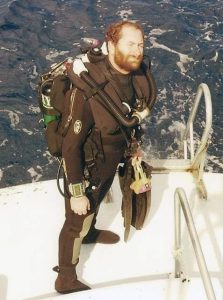
In early 1997, they secured a Small Business Innovation Research grant that provided an injection of capital to fund further R&D on the unit they now called the PRISM Topaz. Pete was particularly interested in Doug McKenna’s work with scrubber material. The two men had met three years earlier at the Acquaintance Day in Pennsylvania, hosted by Barb Lander. During Pete’s presentation, McKenna, a diver and a chemist, proposed using rolls of absorbent material. With the grant, Pete purchased McKenna’s material, filled the PRISM with it, and conducted unmanned testing. The results were promising.
Pete also changed the design of the breathing loop. Initially, the loop had T-piece hose inserts into the counterlungs; after analyzing test data, he discovered the joint affected the mixing and flow of gas through the lungs. To counter the problem, he removed the T-pieces. Instead, he connected the inhalation and exhalation hoses to and from the canister directly into the top of their respective counterlungs. Then, he looped a hose with a mouthpiece across the body, connecting both ends to the lungs via elbow joints.
In early 1998, Pete and Shas started working with Carleton Technologies, which specialized in making rebreathers for the military. As part of the deal, Steam Machines built an updated version of the Mk 15.5 rebreather featuring PRISM electronics for civilian use. The unit was known as the SM1600. About two dozen units were completed, selling for $14,500.
While working with Carleton, Pete had a chance to inspect the radial flow scrubber that went into their SIVA units. Pete liked the design; it was compact and efficient, and he adapted it for use in his PRISM. However, the new scrubber affected the unit’s weight distribution and trim. So, Pete moved the electronics from the base of the scrubber into a machined head, fitted at the top and covered by a brass plate. The sensors were seated under the new electronics bay. Oxygen injection occurred into the expired gas manifold located before the scrubber to aid gas mixing. That way, oxygen went through the absorbent before entering the inhalation cycle.
After a year of development, Steam Machines and Carleton were ready to launch the new look PRISM. They booked a prominent space at DEMA 1999, right by the entrance. For the first time, divers could put down a deposit on a PRISM rebreather. And they did.
Then, Carleton ended the venture. Just like that. Without warning. Pete and Shas were devastated, emotionally and financially. Right then, they’d never felt worse; they couldn’t see a way on. They had bills piling up, no money coming in, and a list of customers who had paid a deposit on a rebreather they were no longer in a position to make. For a moment, they considered something they had never contemplated: giving up. Eight years of effort gone. Just like that.

Pete scrambled around for work and landed an engineering contract. The job kept them afloat, barely. Then, he sold Carleton the design for a mouthpiece, and the money provided another lifeline. Finally, Shas contacted everyone who had put money down on a PRISM and told them there would be a delay in production. She offered each one a refund; they all said no.
Buoyed by the support, Pete and Shas pulled themselves up by the bootstraps. With limited funds, they looked for more cost-effective production opportunities. They agreed that, unfortunately, the machined Delrin heads were too expensive. So, Pete worked with Bruce Omholt/Trinity Engineering/B&E Manufacturing to develop a low-volume casting technique using super-toughened urethanes and high-temperature semi-ceramic epoxies that they matched, blended, cured, and treated.
The new head featured six components that had to be assembled with special glue and cured. They then had to be cleaned, treated, fitted with electronics, and tested four times before approval. Next, a new generation of PRISM electronics was developed with Steve Stewart. For the primary, they opted for a heads-up display, rubber mounted to the mouthpiece, and featuring three bi-colored LEDs that some users nicknamed the Christmas Tree Lights. The primary LEDs showed the PO2 status at all times with various colors, green for normal setpoint, blue for low PO2, red for high PO2, bright red for even higher PO2 and flashing red for anything above 1.55PO2. An additional LED alerted to a sensor alarm or battery power.
The one thing Pete didn’t change was the independent secondary analog display. The jeweled movement meter featured a rotary switch, allowing the diver to select each oxygen sensor independently and look at the PO2 value. The display’s unique feature was that it needed no electronics or battery to operate; it was powered directly from the sensor output.
The analog secondary was essential to Pete. He always taught students to “fly” their rebreathers manually by watching their secondary display and injecting oxygen and diluent. “The primary control system is the diver’s brain,” he told them. It wasn’t until the last dive of class that students were told, “Now you can switch on the electronics and experience a computer-controlled dive.”
A year after hitting rock bottom, Pete and Shas delivered the first PRISM CCR Topaz units. They didn’t ship many to begin with, but it was a start.
US Navy Testing
September 14, 2001: Pete and Shas Readey approached Los Angeles International Airport. It was eerily quiet. Few other cars were about, and armed security personnel outnumbered the passengers milling outside the terminal. Like the rest of the country, the couple were still reeling from the terror attacks, three days earlier, on the World Trade Center.
Flights had only resumed from LAX the previous day, but Pete needed to travel. He carried a memorandum from the US Navy Experimental Diving Unit (NEDU) in Panama City, Florida. The memo stated he was delivering underwater breathing apparatus vital to the Navy and asked that he be permitted to transport the equipment through security.
The PRISM was one of between three and five units being evaluated by Navy personnel as part of a program to see if a commercially available rebreather could meet the demands of SEAL operations. And the Navy was pushing it to the limits.
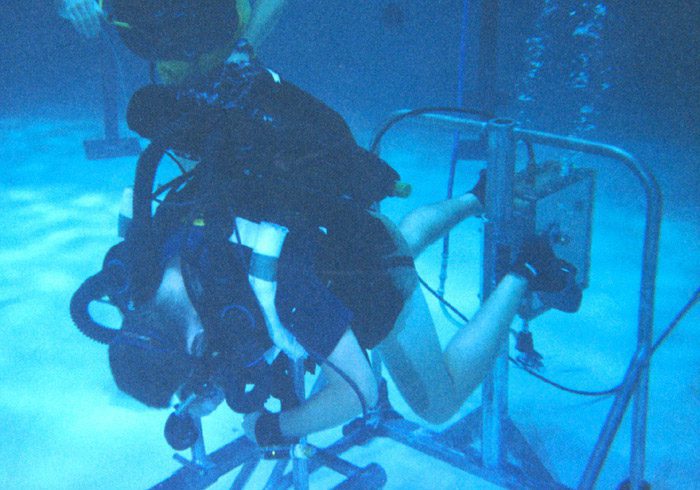
First, the unit underwent 20 hours of bench testing. Then, technicians strapped the machine to a mannequin that simulated the breathing pattern of a diver. They placed the test dummy inside a hyperbaric chamber and studied the unit’s performance for another 150 hours at depths up to 198 fsw/60 m. The technicians measured the PRISM’s breathing resistance in the different positions. They measured the hydrostatic load and the restive load, and they measured the peak-to-peak mouth pressure. They measured the duration of the scrubber canister by injecting carbon dioxide into the mannequin, and they measured the unit’s ability to maintain predetermined setpoints by having the dummy ‘breathe’ with an oxygen consumption rate of up to 2.5 slpm.
The Navy paid particular attention to the unit’s electronics. A computer-controlled CCR was a departure for them, and commanders were nervous. So they had a tech company go through the code, line by line, to ensure it could do what Pete claimed and do so without error.
One person familiar with the testing program said the PRISM performed as well, if not better, than anything else the Navy had. Technicians found the over-the-shoulder counterlungs allowed divers to perform operational tasks in different attitudes underwater without compromising breathing performance.
The feedback made Pete proud. Testing had been one of the pillars (training being another) of his approach to rebreather design. While rebreather designers couldn’t agree on what independent testing should look like, Pete had spent a lot of money putting the performance of his machine to the proof.
So, when he received the Navy’s Technical Memorandum TM01-03 detailing the PRISM’s evaluation, he sought and was given permission to post the document on his website. He posted it to show testing was necessary and to highlight the performance needed to make a product that divers could trust. He posted it because he was proud of his unit’s achievement.
He posted it, and about a month later, his phone started to ring.
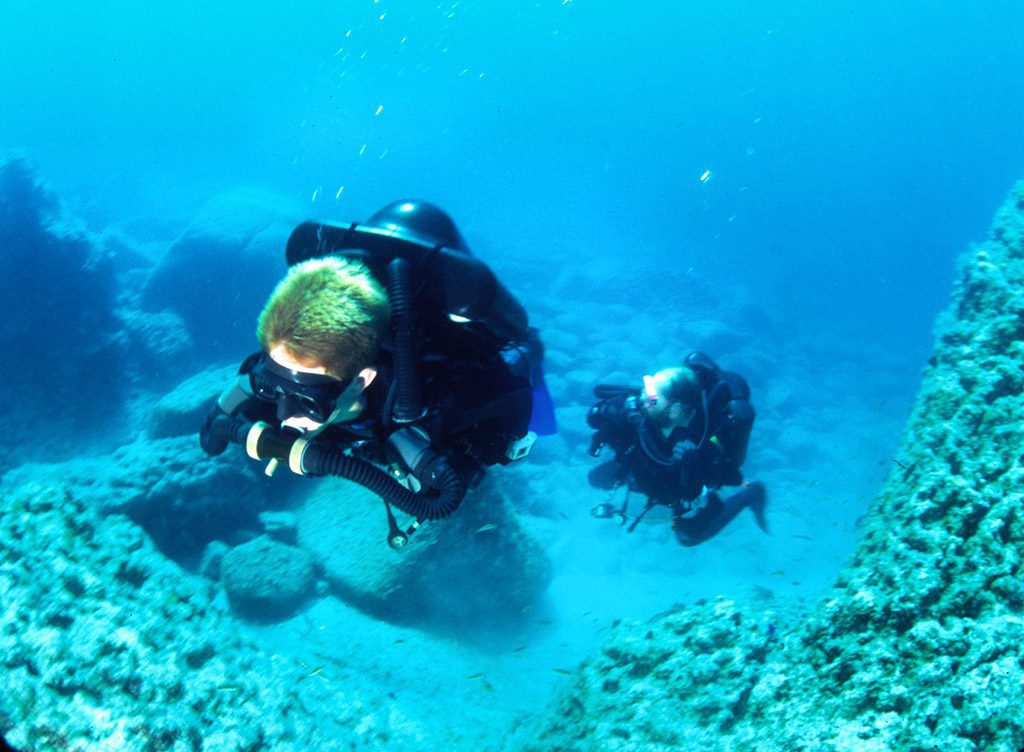
What Pete didn’t appreciate at the time was the public release of the document needed to be signed off by NEDU’s commanding officer, and the CO hadn’t done so. The Navy requested Pete take down the memo. Pete pushed back. The document had been online for some time, he said, and removing it could damage his reputation. The Readeys said they were willing to consider taking down the report and asked the Navy for a note they could post in its place to explain why they had done so. The Navy didn’t respond to the suggestion, so the document remained online.
For a while, Pete found himself in the middle of a firestorm of controversy that threatened to overshadow the testing program. Then the furor just fizzled out. Six weeks later, just after 9/11, Pete was back in Panama City to deliver more units for testing. He returned often to continue training divers. At the Navy’s request, he made modifications to his machine, increasing the size of the scrubber basket to give a diving duration of at least 300 minutes. This new version was dubbed the PRISM Invader.
While testing continued, 14 representatives from the Navy visited the Steam Machines production facility in California. Pete and Shas walked them through the workshop and demonstrated the manufacturing process. The Navy was interested in everything. The three-day audit checked documentation and data control, product identification and traceability, process control, inspection and testing, maintenance planning, training support, storage, purchasing, packaging and personnel. The Readeys thought the Navy expected a lot from a small company with just five employees and stressed they could scale up if the PRISM was chosen.
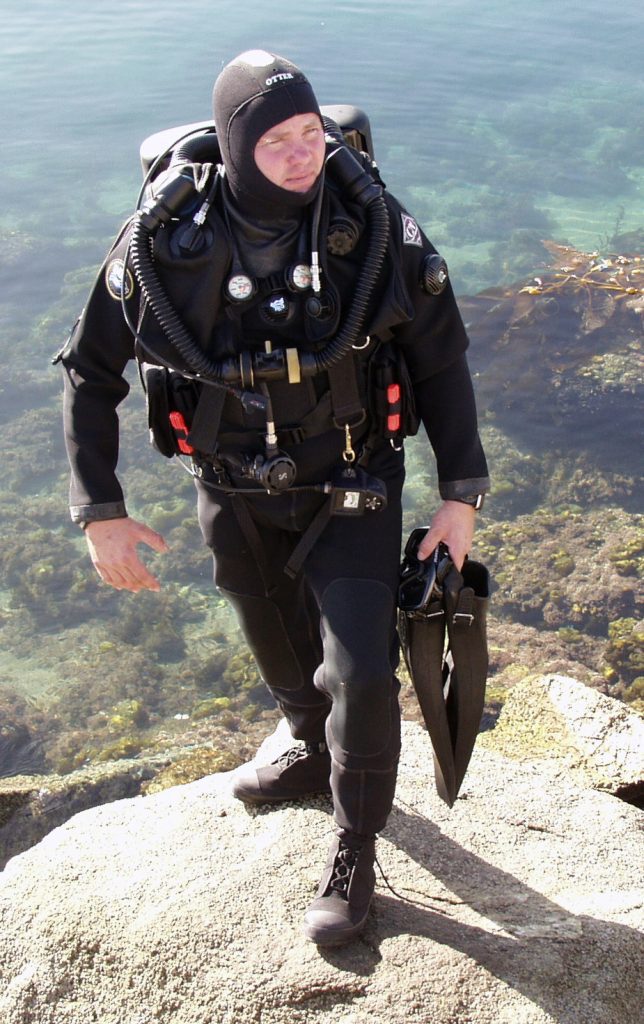
Then, in August 2003, the testing program was abruptly halted.
An official report was prepared explaining why the program had ended, but it was never sanctioned for release to the public. Those who received a copy were prohibited from disseminating the contents. The lack of a public statement allowed all manner of rumors to circulate, some implausible, some ugly, some downright conspiratorial, and all unsubstantiated.
Understanding why the program ended depends very much on who is speaking. There are those who say the Navy was slow to adapt to change and modernization. There are those who say the Navy was not ready to trust a computer-controlled unit. There are those who say Steam Machines was too small for the Navy, whose trust in suppliers seemed to be proportional to their financial clout. Then, there are those who claim the rig was not safe for Navy diving.
There were, apparently, a handful of critical evaluation reports. One diver was scathing about the unit after he almost suffered a hyperoxic episode on an open-water dive. He had also suffered a similar event during a pool dive. Someone familiar with the program said the incident likely resulted from operator error; the diver was used to another machine with a different configuration and was mistakenly pressing the manual addition for oxygen instead of diluent.
Then a test diver was making an open water dive when his ADV failed to add gas on descent, leaving him gasping for breath. He was angry and said so in his after-action report. Technicians examined his rig and found the striker plate behind the ADV was partly detached. A check of the Navy’s inventory of PRISMs found the part had come unglued on other units.
By the time Pete learned of the problem, it was too late; the testing program had been halted. (Pete believed the issue was caused by how divers rolled the counterlung during disassembly and storage, and on future models, he stitched rather than glued the striker plate into place).
The decision to end testing of the PRISM was a surprise to some in Navy test diving circles who viewed the unit as a potential candidate to replace what was then in service.
While Pete was disappointed, he was not downhearted. His machine had been put through the best testing money could buy, had improved in design, and had won the approval of many of the divers who had evaluated it.
In late 2003, Pete saw that the Navy had launched a new program for an Advanced Tactical Underwater Breathing Unit (ATUBA), and he briefly considered applying. The contract for the ATUBA was eventually awarded to Bob Hollis. Four years later, Hollis approached Pete and asked to buy the PRISM.
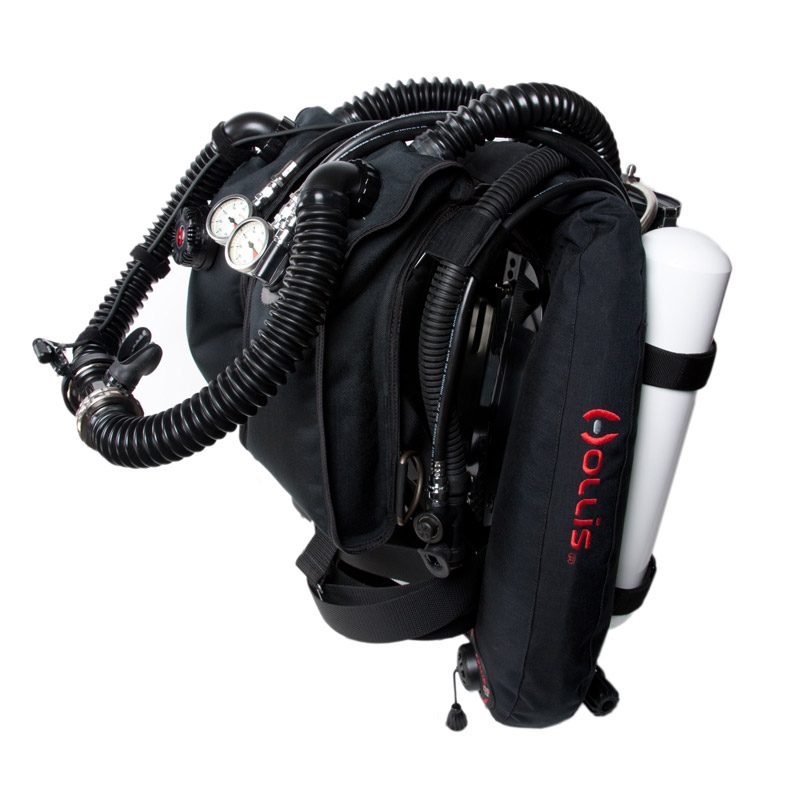
Teaming up with Hollis
Oceanic founder Bob Hollis believed in the benefits of rebreathers right from his early days of diving. An avid underwater photographer, he first used a Draeger unit in the 1960s to get close to sea otters in Monterey Bay. A few years later, he took Walter Starck’s short-lived Electrolung 91 meters/300 feet down in Honduras and Bonaire to film shipwrecks and deep reefs.
In 1992, Hollis began working with Stuart Clough on a unit called the Phibian. Developing a rebreather was a big undertaking, perhaps bigger than Hollis expected, and he sank more than $2 million into the project because he felt rebreathers were the frontier of diving.
“The opportunity for rebreathers is now,” he said in the Xplorers issue of aquaCORPS in 1995.
The opportunity didn’t arrive, though, and the prototype Phibian did not make it beyond the testing phase.
Ten years later, while developing the Advanced Tactical Underwater Breathing Apparatus (ATUBA) for the Navy, Hollis heard good things from them about the performance of PRISM. Interested in the data, he went looking for Pete Readey.
After the disappointment of the Navy program, Pete and Shas left California and moved to a farm near Nashville, Tennessee. They converted a 1920s tobacco barn into a production facility and, by March 2005, were funneling all their energy into making the Topaz a success under their own steam. The unit had established a hardcore following, and in 2006, they delivered more units to divers than ever before. Still, they could not make them fast enough to meet demand.
In 2007, Pete was at the Steam Machines booth at the Beneath the Sea exhibition in New Jersey when Hollis came to see him. Bob asked if he could buy the PRISM design, and just like that, Pete’s dream, the one that had charged his life for 15 years, was within reach. They signed a deal, and in September 2007, the PRISM Topaz officially became the Hollis PRISM 2.
Having purchased a solid rebreather, Hollis knew not to mess with its function. He did, however, need to change the materials and make associated design alterations so he could manufacture the rebreather using injection plastic molding, a technique he favored for high-quality mass production.
Hollis brought in engineer Art Ferguson, who had previously worked for him, to prepare the PRISM for production. Ferguson had, at one time or another, designed almost every piece of scuba equipment. (“Except a snorkel,” he said. “Well, I did design a snorkel, but it never went into production”). He had worked on the Phibian and ATUBA projects and knew his way around a rebreather.
“Pete’s PRISM was a very elegant, low-volume design,” Ferguson said. “I had to take that model and redesign the individual parts for high-volume production.
“We did some clever things with the O2 injector, and I did things to improve the established routing—nothing functional because we already had a working unit. Pete was there to make sure everything was functionally good.” Alongside his work with Ferguson, Pete also lent his expertise to the ATUBA project. Eventually, Hollis delivered three proof-of-concept units to the Navy, but the project ended before they were tested.
The injection molding process allowed the Hollis design team to introduce new materials to strengthen the unit, said Chauncey Chapman, project manager on the PRISM 2 and ATUBA projects.
Like Art Ferguson, Chapman had received his foundation in rebreather design while working with Stuart Clough on the Phibian. “I stuck to him like a lamprey to a shark,” he said. “Stuart was so generous with information. One time I asked him how complex these things were. He asked if I had a shampoo bottle at home, and the next day we made a rebreather from the bottle and a couple of other parts. And the damned thing worked.”
When it came to PRISM 2, Chapman’s team opted to make the scrubber basket from glass fiber-reinforced ABS plastic and the head from glass-filled nylon. Keen to retain the transparent bucket that made Pete’s unit so distinct, they searched for a see-through material that could withstand the rigors of diving. They experimented with a product called Isoplast 301 and, after a couple of setbacks, produced crystal clear parts that were “tougher than nails”.
Chapman worked with Shearwater Research on a new computer control system and handset to replace the PRISM’s electronics. His team also changed the direction of flow in the breathing loop, switching the inhalation counterlung and diluent tank to the left and the exhalation counterlung and oxygen tank to the right to match what had become the convention in civilian rebreathers.
“What Pete did with the PRISM was spectacular,” said Chapman, “but it was not just the quality of the engineering or manufacturing process; it was also the relationships Bob Hollis had with the diving and manufacturing community that made the PRISM 2.”

The first PRISM 2 entered the US market in 2009. Nick Hollis, brand manager for Oceanic and Hollis, said the rebreather established itself as one that divers could trust because they knew to expect the same level of customer service, production standards and dealer support they enjoyed with their open circuit gear. Its key selling points, he said, were that it was simple to use and reliable, performing consistently to ensure users didn’t miss a dive. Built from durable materials that required fewer parts than most units also meant that it was easy to service.
In 2017, Huish Outdoors acquired the Oceanic and Hollis brands from American Underwater Products. A separate entity, Hollis Rebreathers LLC, was formed to develop the PRISM 2. While benefiting from a close relationship with Huish Outdoors and based at the same HQ in Salt Lake City, Utah, the company was established to operate independently to properly focus on the core rebreather business.
In 2019, Hollis Rebreathers announced the PRISM 2 had passed the stringent testing standards to receive European CE approval. The testing process showed the PRISM 2 had some of the best work of breathing numbers on the market. The certification allowed the company to meet growing interest internationally and showed customers that Hollis had built a unit to a quality process and standard, Nick said.
“My dad had the vision for bringing the PRISM 2 to life. He put together an amazing team, and between that and the vision he had it has created an amazing product and one that a lot of customers are happy with,” said Nick.
“He always has a real being interest in [rebreathers]. When the Prism caught his eye, he saw that as the opportunity to put something out that was truly great and different for the consumer. I think he achieved his goal.”
By the time PRISM 2 received its CE mark, Pete had already moved on to other things, and in 2019, he began working with aerospace company Paragon Space Development Corp.
Now he is using his knowledge of life support systems in a new endeavor, working as part of NASA’s Artemis Program, which aims to send astronauts back to the moon. For the first time since he started work on his prototype PRISM rebreather 30 years ago, Pete stopped looking down, wondering what lies beneath the water’s surface. Now he is gazing up at the stars, thinking about how to keep the next generation of explorers alive in deep space.
DIVE DEEPER
aquaCORPS: Stuart Clough interview by Michael Menduno (1993)
aquaCORPS: $2,000,000 Man by Michael Menduno (1995)
aquaCORPS: Ready When You Are by Michael Menduno (1996)
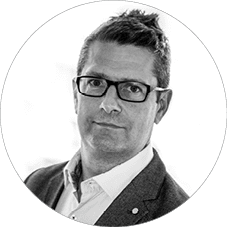
Mark Cowan is a journalist with over two decades’ experience in newspapers and television. He spent twelve years on the police beat covering the war on crime for a series of newspapers in Birmingham, UK, and reported on the peace-keeping operations in war-torn Kosovo while embedded with the British Army. He has worked on a number of documentaries, including the BAFTA-winning Gun Number 6 which was inspired by his original reporting on the realities of gun crime in the UK. He has been a diver for 20 years, is a PADI Master Scuba Diver Trainer, trained to use a rebreather in 2012, and learned to cave dive while researching and writing the book “Between the Devil and the Deep, One Man’s Battle to Beat the Bends,” with co-author Martin Robson. He is an avid wreck diver and is now based in Chicago, Illinois.
Taking PRISM To The Extreme

“The Prism has been such a huge part of our company and my diving career,” says Ben Daughtry of Florida-based Dynasty Marine. “I have been able to do things on the rig that I couldn’t do on open circuit.”
For 27 years, Ben has been involved in a business collecting Caribbean marine life for public aquariums and high-end wholesale and retail facilities, first as a diver and now as president of the company.
He has spent most of his professional diving career on a Topaz, making 500 dives a year at its height. His divers still use the Prism Topaz today.
Already a technical diver, Ben was introduced to rebreathers in 1996 in Key West when he attended one of Pete Readey’s introductory events at the home of diving pioneer Billy Deans..
After listening to Pete and completing a try dive on an Mk15.5 unit, Ben knew rebreathers could revolutionize the business, maximizing their time underwater and improving safety.
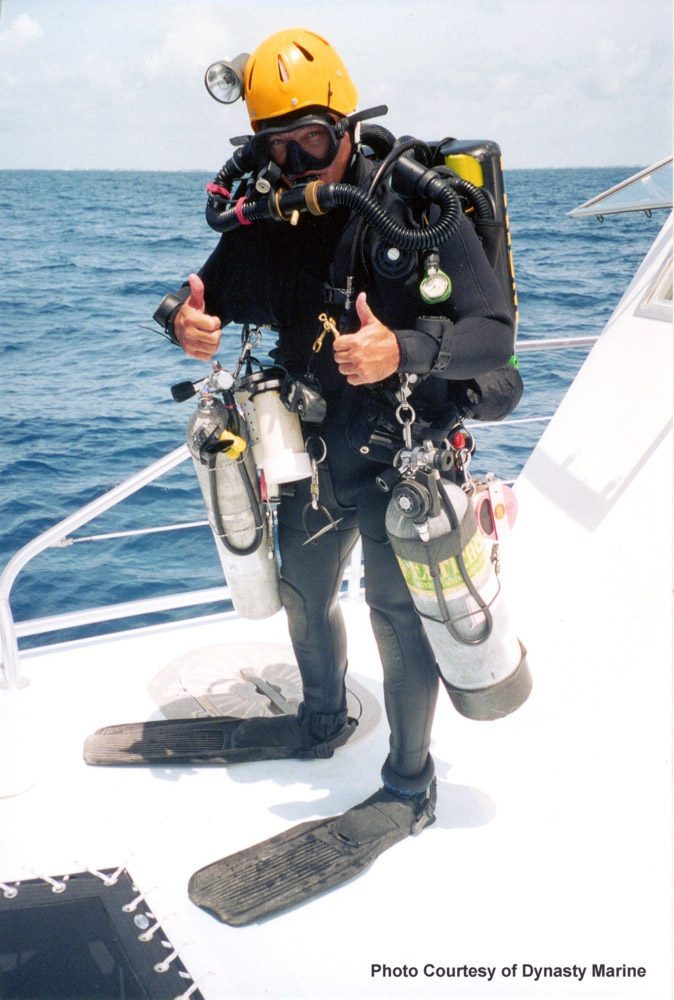
Three years later, in 1999, he and Dynasty founder Forrest Young were at the Steam Machines production facility in California, assembling their units under the watchful eye of Pete.
“One of the most incredible things was to spend time with the inventor of the machine you are diving,” he said.
“Every time we sat down for a meal, Pete would run through scenarios,” he said. “They always started the same: ‘You are swimming along merrily when something happens. What do you do?’ He would get us to think through the problem and how we would handle it.
“We ran through hundreds of scenarios on how the machine could fail. It gave me the most confidence to dive the machine for many years at different depths.”
In that time, Ben and his team have taken Prism to the extremes. They have run remote expeditions to north Sulawesi and the Philippines. They routinely used the unit to dive below 70 meters, where the change in habitat and the thermoclines revealed rare, deep-water fish. Ben has plenty of dives to 100 meters and more in the 125-meter range. The deepest? One hundred and fifty meters – 500 feet.
“That shows what the machine is capable of,” he said.
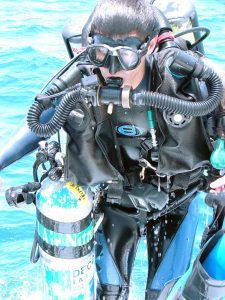
“I don’t know that there is a place on the planet, on the surface, that you can go to that no human has touched, but there is still a lot of that in the ocean. I know I have been to places no other person has been; that is pretty cool.”
The simplicity of the machine, the intimate knowledge he developed with his unit over the years, and the ability to go “full analog” and fly it manually, are among the benefits of the Topaz.
“I like to fly the machine manually, which goes back to Pete talking about knowing what your machine is doing, not being complacent,” said Ben.
As well as his role running a sustainable fish collecting operation, Ben is also a representative for Marine Life Commercial Fishery on the Florida Keys National Marine Sanctuary Advisory Council, and VP of the Florida Marine Life Association. He doesn’t get as much time to dive the unit as he once did. The company’s divers continue to get a tremendous amount of work out of the Topaz, three or four hours underwater at a time, and Ben said he sees no reason to change.
“Pete understood the flaws in other machines, and he worked to make his machine better, to engineer the flaws on other machines out of his,” he said.
“The unit is not the fanciest car on the lot; it’s a pick-up truck, a workhorse, and it continues to run. We have had incredible luck with that rig.”






















































